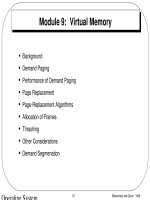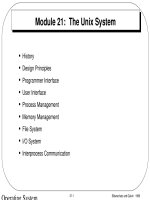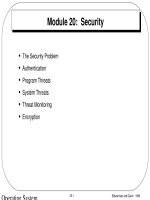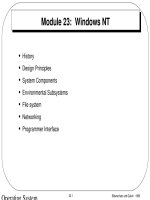Lecture Operating system concepts - Module 4
Bạn đang xem bản rút gọn của tài liệu. Xem và tải ngay bản đầy đủ của tài liệu tại đây (455.46 KB, 34 trang )
Module 4: Processes
•
•
•
•
•
Process Concept
Process Scheduling
Operation on Processes
Cooperating Processes
Interprocess Communication
4.1
Silberschatz and Galvin
1999
Process Concept
•
An operating system executes a variety of programs:
– Batch system – jobs
– Time-shared systems – user programs or tasks
•
Textbook uses the terms job and process almost
interchangeably.
•
Process – a program in execution; process execution must
progress in sequential fashion.
•
A process includes:
– program counter
– stack
– data section
4.2
Silberschatz and Galvin
1999
Process State
•
As a process executes, it changes state
– new: The process is being created.
– running: Instructions are being executed.
– waiting: The process is waiting for some event to occur.
– ready: The process is waiting to be assigned to a process.
– terminated: The process has finished execution.
4.3
Silberschatz and Galvin
1999
Diagram of Process State
4.4
Silberschatz and Galvin
1999
Process Control Block (PCB)
Information associated with each process.
•
•
•
•
•
•
•
Process state
Program counter
CPU registers
CPU scheduling information
Memory-management information
Accounting information
I/O status information
4.5
Silberschatz and Galvin
1999
Process Control Block (PCB)
4.6
Silberschatz and Galvin
1999
CPU Switch From Process to Process
4.7
Silberschatz and Galvin
1999
Process Scheduling Queues
•
•
Job queue – set of all processes in the system.
•
•
Device queues – set of processes waiting for an I/O device.
Ready queue – set of all processes residing in main memory,
ready and waiting to execute.
Process migration between the various queues.
4.8
Silberschatz and Galvin
1999
Ready Queue And Various I/O Device Queues
4.9
Silberschatz and Galvin
1999
Representation of Process Scheduling
4.10
Silberschatz and Galvin
1999
Schedulers
•
Long-term scheduler (or job scheduler) – selects which
processes should be brought into the ready queue.
•
Short-term scheduler (or CPU scheduler) – selects which process
should be executed next and allocates CPU.
4.11
Silberschatz and Galvin
1999
Addition of Medium Term Scheduling
4.12
Silberschatz and Galvin
1999
Schedulers (Cont.)
•
Short-term scheduler is invoked very frequently (milliseconds)
(must be fast).
•
Long-term scheduler is invoked very infrequently (seconds,
minutes) (may be slow).
•
The long-term scheduler controls the degree of
multiprogramming.
•
Processes can be described as either:
– I/O-bound process – spends more time doing I/O than
computations, many short CPU bursts.
– CPU-bound process – spends more time doing
computations; few very long CPU bursts.
4.13
Silberschatz and Galvin
1999
Context Switch
•
When CPU switches to another process, the system must save
the state of the old process and load the saved state for the new
process.
•
Context-switch time is overhead; the system does no useful work
while switching.
•
Time dependent on hardware support.
4.14
Silberschatz and Galvin
1999
Process Creation
•
Parent process creates children processes, which, in turn create
other processes, forming a tree of processes.
•
Resource sharing
– Parent and children share all resources.
– Children share subset of parent’s resources.
– Parent and child share no resources.
•
Execution
– Parent and children execute concurrently.
– Parent waits until children terminate.
4.15
Silberschatz and Galvin
1999
Process Creation (Cont.)
•
Address space
– Child duplicate of parent.
– Child has a program loaded into it.
•
UNIX examples
– fork system call creates new process
– execve system call used after a fork to replace the process’
memory space with a new program.
4.16
Silberschatz and Galvin
1999
A Tree of Processes On A Typical UNIX System
4.17
Silberschatz and Galvin
1999
Process Termination
•
Process executes last statement and asks the operating system
to decide it (exit).
– Output data from child to parent (via wait).
– Process’ resources are deallocated by operating system.
•
Parent may terminate execution of children processes (abort).
– Child has exceeded allocated resources.
– Task assigned to child is no longer required.
– Parent is exiting.
Operating system does not allow child to continue if its
parent terminates.
Cascading termination.
4.18
Silberschatz and Galvin
1999
Cooperating Processes
•
Independent process cannot affect or be affected by the
execution of another process.
•
Cooperating process can affect or be affected by the execution of
another process
•
Advantages of process cooperation
– Information sharing
– Computation speed-up
– Modularity
– Convenience
4.19
Silberschatz and Galvin
1999
Producer-Consumer Problem
•
Paradigm for cooperating processes, producer process produces
information that is consumed by a consumer process.
– unbounded-buffer places no practical limit on the size of the
buffer.
– bounded-buffer assumes that there is a fixed buffer size.
4.20
Silberschatz and Galvin
1999
Bounded-Buffer – Shared-Memory Solution
•
Shared data
var n;
type item = … ;
var buffer. array [0..n–1] of item;
in, out: 0..n–1;
•
Producer process
repeat
…
produce an item in nextp
…
while in+1 mod n = out do no-op;
buffer [in] :=nextp;
in :=in+1 mod n;
until false;
4.21
Silberschatz and Galvin
1999
Bounded-Buffer (Cont.)
•
Consumer process
repeat
while in = out do no-op;
nextc := buffer [out];
out := out+1 mod n;
…
consume the item in nextc
…
until false;
•
Solution is correct, but can only fill up n–1 buffer.
4.22
Silberschatz and Galvin
1999
Threads
•
A thread (or lightweight process) is a basic unit of CPU utilization;
it consists of:
– program counter
– register set
– stack space
•
A thread shares with its peer threads its:
– code section
– data section
– operating-system resources
collectively know as a task.
•
A traditional or heavyweight process is equal to a task with one
thread
4.23
Silberschatz and Galvin
1999
Threads (Cont.)
•
In a multiple threaded task, while one server thread is blocked
and waiting, a second thread in the same task can run.
– Cooperation of multiple threads in same job confers higher
throughput and improved performance.
– Applications that require sharing a common buffer (i.e.,
producer-consumer) benefit from thread utilization.
•
Threads provide a mechanism that allows sequential processes
to make blocking system calls while also achieving parallelism.
•
•
Kernel-supported threads (Mach and OS/2).
•
Hybrid approach implements both user-level and kernelsupported threads (Solaris 2).
User-level threads; supported above the kernel, via a set of
library calls at the user level (Project Andrew from CMU).
4.24
Silberschatz and Galvin
1999
Multiple Threads within a Task
4.25
Silberschatz and Galvin
1999









